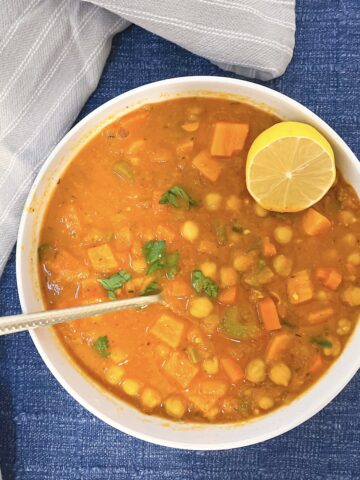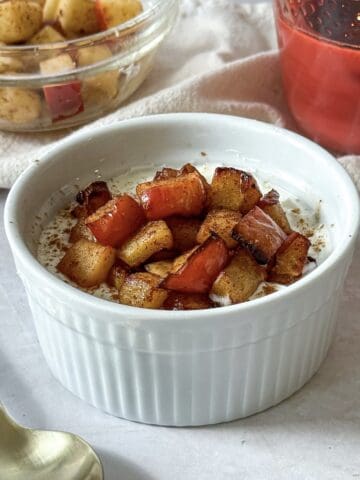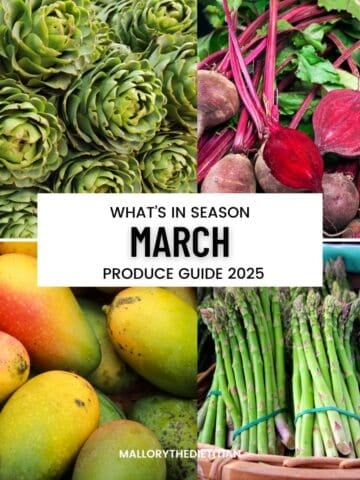In recent years, there has been an increase in people following a plant-based diet for the many health benefits it provides. As a registered dietitian, I love getting asked about eating more plants and how to get more protein on a plant-based diet.
In this post, I share what plant-based eating is, the health benefits of plant-based eating, and some tips for how to get started. Don't miss the cheat sheet for plant-based protein recommendations!

Jump to:
- What is a Plant-Based Diet?
- What is Included on a Plant-Based Diet
- Health Benefits of a Plant-Based Diet
- Getting Started on a Plant-Based Diet
- How to Get Protein on a Plant-Based Diet
- Protein Sources on a Plant Based Diet
- In Conclusion
- LOOKING FOR MORE NUTRITION EDUCATION?
- CHECK OUT THESE NOURISHING Dietitian RECIPES
- 💬 Comments
What is a Plant-Based Diet?
A plant-based diet is an eating pattern high in plant foods including fruits, vegetables, nuts, seeds, legumes, oils, and whole grains. People decide to eat more plants or completely avoid animal proteins for several reasons. Often those reasons are personal and align with the values of the person.
Some examples of why people decide to eat more plants include animal rights, helping the environment by decreasing greenhouse gas emissions, certain health outcomes such as prevention or treatment of chronic conditions or weight loss, religious reasons, or simply because they prefer plant foods over animal foods.
In general, a vegetarian is a person who does not eat meat. But there are several specifications of a plant-based diet or vegetarian diets.
- Flexitarian: While predominantly vegetarian, people following a flexitarian diet still eat a small amount of meat, poultry, and seafood which may include dairy or eggs.
- Pescatarian: Predominantly vegetarian with the inclusion of seafood and fish.
- Vegetarian or lacto-ovo vegetarian: Do not eat animal flesh but do eat animal-based foods such as eggs, honey, and dairy products including milk.
- Vegan diet: Entirely plant-based and excludes both animal flesh and animal byproducts. Typically, people decide to be vegan for ethical reasons such as animal empathy.
- Plant-forward: A style of cooking and eating that emphasizes plant-based foods but isn’t limited to them.

What is Included on a Plant-Based Diet
When it comes to what's included in a plant-forward eating pattern, there is no lack of variety! Fruits and vegetables are the first thing that comes to mind, but there are so many more options.
The foods on this list are all included on a plant-based diet:
- Fruit - Fresh fruit and frozen or canned fruit are great options. Many fruits contain vitamin C and other important vitamins and minerals to help meet your nutritional needs. Try to steer clear of fruit juice that tends to be high in sugar and low in fiber.
- Vegetables - There are endless vegetable options from leafy greens to starchy vegetables like potatoes. Vegetables contain several micronutrients just like fruit. For example, sweet potatoes and carrots are high in Vitamin A.
- Legumes - This includes beans, peas, and lentils. Legumes are whole plant foods that are often a source of protein on a plant-based diet.
- Nuts and Seeds - Nuts and seeds also contain protein and are a good source of fiber. Nut butters are also included! Many nuts and seeds contain vitamin E, an important nutrient for brain health.
- Whole Grains and products made from whole grains- Whole grains include brown rice, black rice, red rice, wild rice, buckwheat, bulgar, corn, quinoa, and oatmeal. Whole grains are high in dietary fiber and good for gut health, too!
- Oils - Olive oil, avocado oil, safflower oil, sunflower oil, walnut oil, and soybean oil are all common cooking oils.
This is not an exhaustive list and there are endless options of plant-based foods. Many vegan chefs are forced to get creative and find unique ways to create dishes with an unrivaled depth of flavor!

Health Benefits of a Plant-Based Diet
The Mediterranean diet is a popular plant-forward way of eating with scientific evidence that backs up its healthfulness. The main reason it is so healthy is that it consists of mostly plants.
Research has also shown that a healthy plant-based diet such as a vegetarian diet high in whole foods has quite a few potential health benefits. A recent article in Nutrients, a peer-reviewed journal, outlines many of these benefits.
Some of the health benefits of eating high-quality plant foods include:
- A decreased risk of developing chronic diseases including a lower risk of heart disease and type 2 diabetes.
- Many plant foods can help to lower cholesterol levels, in particular low-density lipoprotein cholesterol (LDLs).
- Can help lower blood pressure.
- Can reduce arthritic pain.
- Linked to a lower cancer risk. For example, this study from the Journal of the American College of Nutrition showed that a high intake of anthocyanins, flavonoids found in some plants including berries, purple grapes, and cabbage, may play a role in preventing colorectal cancer.
- Can lead to a decrease in inflammation in the body which is important for many aspects of good health.
- Enhances the immune system.
- Has positive and protective effects on metabolic health leading to a decreased risk of metabolic syndrome.
- Supports brain health and may help prevent neurodegenerative diseases including Alzheimer's disease.
- Linked with improved blood sugar control which helps with cravings and energy levels.
- Can help with weight loss, lower body mass index (lower BMI), and healthy weight management.
- Improvements in skin, sleep, and energy levels.
But there is a difference between a healthy plant-based diet and an unhealthy plant-based diet.
To reap the health benefits, aim to eat plant sources of fiber, phytonutrients, and micronutrients including vitamins and minerals. As much as possible, avoid ultra-processed foods like french fries and potato chips, sugar-sweetened beverages, and other foods and beverages high in refined sugars.

Getting Started on a Plant-Based Diet
The good news is that if you are thinking about incorporating more plants into your diet, there are endless options to choose from and you can cater to your taste.
Here are some tips to help you get started on a plant-based diet.
Adopt a “What Can I Add” Mentality
Start to look at your plate with a “what can I add” attitude and make that addition a plant. Aim to make half your plate vegetables and fruit, a quarter whole grains, and the rest an animal or plant-based protein. Top it with an oil-containing dressing or avocado for more healthy fats.
And remember, a plant-based diet doesn't necessarily mean that you don't ever eat animal products. It simply means emphasizing adding more plants so that they are a majority of what you eat!
Opt for Plant-Based Snacks and Meals
Start trying different plant-based recipes. There is a lot of flavor in plant foods when you learn to cook them right so don't be afraid to experiment with new flavor combinations. Try Smoky Chickpea Soup, Roasted Red Pepper Soup, Chia Pudding, or a Nourish Bowl with a Tahini Dressing.
If you don't like to cook, no problem at all. Choose the vegetarian option from the menu when eating out.
And don't stop at meals! There are plenty of plant-based snacks to choose from. Try your hand at making homemade hummus, dill pickle popcorn, date snickers, 4-ingredient oatmeal cookies, or air fryer apples. If you prefer grab-and-go snacks, here is a complete list of snacks I buy as a dietitian.
Start Slow
If you want to get started on a plant-based diet, you don't have to do it all at once. Start by aiming to eat 1-2 plant-based meals a week and then slowly increase the number you eat.
Be Open to New Foods
There is a whole world of flavor when you are open to trying new plant-based foods. Make it a goal to try one new vegetable, fruit, nut, or legume each week. Experiment cooking with that food and try cooking it different ways. You might be surprised to find a new favorite!
Supplement as Needed
By cutting back on meat, you decrease your intake of cholesterol and saturated fats, both of which are found in meats and animal products and can have a negative impact on heart health and overall health.
But you also run the risk of some deficiencies by decreasing or cutting out animal products. Red meat is high in iron, dairy products like milk and yogurt are good sources of calcium and Vitamin D, and salmon is high in Omega-3 fatty acids.
The most common deficiencies to look out for on a plant-based diet are vitamin B-12, vitamin D, calcium, Omega-3, iron, and zinc.
If you are starting a plant-based diet or any other dietary intervention, always talk with a healthcare provider or registered dietitian to make sure you are meeting all your needs for essential nutrients. You may need a daily supplement.

How to Get Protein on a Plant-Based Diet
One of the biggest questions people have about a plant-based diet is how to get enough protein. You don't have to eat an omnivorous diet to get all your essential amino acids, the building blocks of protein! There are plenty of protein-rich plant-based foods, and often plant protein can be less expensive than animal protein.
When it comes to how much protein you need in a day, it varies based on the individual. However, the general dietary guidelines recommend 0.8 grams of protein per kilogram of body weight. This comes to around 55 grams of protein per day for a 150 lb female or 65 grams of protein per day for a 180 lb male.
To meet all your essential nutrient needs, be sure to get a variety of plant proteins since each plant has different micronutrients.
Protein Sources on a Plant Based Diet
Nuts and Nut Butters Protein
- Almonds -14 grams per ½ cup.
- Almond Butter - 6 grams in 2 tablespoon (Justin's Brand).
- Brazil Nuts - 4 grams in 9 nuts.
- Cashews - 10 grams per ½ cup.
- Cashew Butter - 5 grams in 2 tablespoon (Once Again brand).
- Hazelnuts - 10 grams per ½ cup
- Macadamia Nuts - 4 grams per ½ cup.
- Pecan Halves - 6 grams in ½ cup.
- Pine Nuts - 8 grams in ½ cup.
- Pistachios, shelled - 12 grams per ½ cup.
- Walnuts, shelled - 10 grams in ½ cup.
- Walnut Butter - 5 grams per 2 tablespoon (Artisana Brand).
Protein in Legumes
- Black Beans: 15 grams per 1 cup. Grab a can of dried beans and add them to Turkey Chili.
- Cannellini Beans - 14 grams in 1 cup.
- Chickpeas (aka garbanzo beans): 12 grams, 1 cup cooked. Grab a can and add it to recipes like in this Smoky Chickpea Soup or make homemade hummus with veggies or Mediterranean Roasted Chickpeas as a snack.
- Edamame Beans - 18 grams per 1 cup shelled. You can find frozen edamame and pop it in the microwave for an easy option.
- Fava Beans (Broadbeans) - 14 grams in 1 cup cooked.
- Great Northern Beans - 19 grams, 1 cup cooked.
- Kidney Beans -14 grams per 1 cup cooked.
- Large Butter Beans - 14 grams in 1 cup cooked.
- Lima Beans - 15 grams, 1 cup cooked.
- Navy Beans - 19 grams per 1 cup cooked.
- Pinto Beans - 12 grams, 1 cup cooked.
- Peanuts - 14 grams in ½ cup.
- Peanut Butter - 7 grams per 2 tablespoon (Justin's Brand).
- Red Lentils: 24 grams in 1 cup cooked. Lentils are great to add in soups and power bowls.
- Black Eyed Peas - 12 grams, 1 cup cooked (canned)
- Green Peas: 8 grams per 1 cup. You’ll see pea protein show up in plant-based protein powders and bars.
Seeds and Seed Butter Protein
- Chia Seeds - 5 grams per 2.5 Tbsp.
- Flax Seeds - 4 grams in 2 Tbsp.
- Hemp Seeds, shelled - 10 grams per 3 Tbsp. Throw them in a smoothie or make homemade granola with hemp seeds.
- Pumpkin Seeds (pepitas) - 8 grams, ¼ cup.
- Sesame Seeds - 4 grams, 2 Tbsp.
- Sunflower Seeds, kernels - 6 grams per ¼ cup.
- Sunflower Seed Butter - 7 grams in 2 tablespoon (Sunbutter brand).
- Tahini - 8 grams per 2 Tbsp. Tahini is made from sesame seeds and is a common ingredient in Mediterranean dishes such as hummus.
Protein in Whole Grains for Plant-Based Diet
- Brown Rice - 5 grams in 1 cup cooked.
- Oats, Rolled (Old Fashioned Oats)- 10 grams per 1 cup
- Quinoa - 8 grams, 1 cup cooked.
- Seitan aka “wheat meat” - 25 grams per 3.5 oz. It takes on a similar texture as meat when cooked and has a savory meat-like taste similar to chicken or portobello mushroom. *Contains gluten.
Soy Products and Other Protein for Plant-Based Diet
- Soy Milk - 7 grams in 1 cup (Silk brand).
- Tofu: 8 grams per 3 ounces (Whole Foods 365 brand)
- Tempeh (fermented soybeans) - 18 grams in 3 ounces (Lightlife Brand).
- Nutritional Yeast - 5 grams, 2 Tbsp

In Conclusion
Don't underestimate the power of a plant-based diet. Eating a healthy diet with more nutrient-rich plants has been shown to have many health benefits including decreasing the risk of cardiovascular disease, cholesterol, high blood pressure, certain cancers, and type 2 diabetes. It can also help support brain health, gut health, and weight loss.
Add nutrient-dense plants and work with a registered dietitian to make sure you are meeting all your nutrition needs!
I hope you enjoyed this article about the plant-based diet! I would love to hear from you if so. Please leave me a comment below or find me on Instagram....I LOVE knowing there’s people out there reading my articles. 🙂 IG: @mallorythedietitian
References: Harvard Health Publishing, PennState University, American Heart Association, Nutrients, Journal of the American College of Nutrition, Mayo Clinic
LOOKING FOR MORE NUTRITION EDUCATION?
Here are some of my educational posts you may enjoy:





























Comments
No Comments